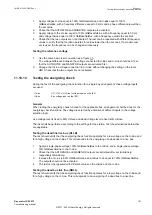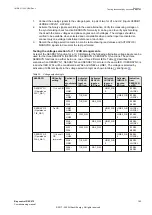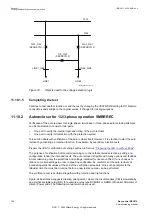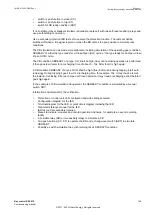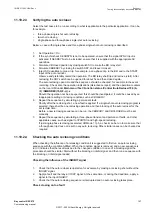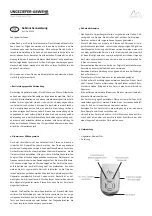
11.9.2.5
Checking the operation of the du/dt and di/dt based function
M1405-96 v12
Check the operation of the du/dt and di/dt based function if included in the IED.
1.
Simulate normal operating conditions with the three-phase currents in phase with their
corresponding phase voltages and with all of them equal to their rated values.
2.
Change the voltages and currents in all three phases simultaneously.
The voltage change must be higher than the set value
DU>
and the current change must be
lower than the set value
DI<
.
•
The BLKU and BLKZ signals appear without any time delay. The BLKZ signal will be
activated only if the internal deadline detection is not activated at the same time.
•
3PH should appear after 5 seconds, if the remaining voltage levels are lower than the set
UDLD<
of the dead line detection function.
3.
Apply normal conditions as in step
.
The BLKU, BLKZ and 3PH signals should reset, if activated, see step
.
4.
Change the voltages and currents in all three phases simultaneously.
The voltage change must be higher than the set value
DU>
and the current change must be
higher than the set value
DI<
.
The BLKU, BLKZ and 3PH signals should not appear.
5.
.
6.
Connect the nominal voltages in all three phases and feed a current below the operate level in
all three phases.
7.
Keep the current constant. Disconnect the voltage in all three phases simultaneously.
The BLKU, BLKZ and 3PH signals should not appear.
8.
Change the magnitude of the voltage and current for phase 1 to a value higher than the set
value
DU>
and
DI<
.
9.
Check that the start output signals STDUL1 and STDIL1 and the general start signals STDU or
STDI are activated.
10.
Check that the start output signals for the current and voltage phases 2 and 3 are activated by
changing the magnitude of the voltage and current for phases 2 and 3.
11.9.2.6
Completing the test
M1405-130 v5
Continue to test another function or end the test by changing the
TESTMODE
setting to
Off
. Restore
connections and settings to the original values, if changed for testing purposes.
11.9.3
Fuse failure supervision VDSPVC
GUID-DCCD4C4A-8335-43BA-A2B2-9994380985B0 v2
Prepare the IED for verification of settings as outlined in section
GUID-004BFFE4-B1C1-4C0E-8D7A-ABE7B566AB28 v2
Checking the operation of binary input and output
1.
Simulate normal operation conditions with three-phase voltage on the main fuse group and the
pilot fuse group. Ensure the values are equal to their rated values.
2.
Disconnect one of the phase voltage from the main fuse group or the pilot fuse group. Observe
the binary outputs of the IED. The MAINFUF or the PILOTFUF signals are simultaneously
activated. Only the output circuit related to the open phase will be active i.e either MAINFUF or
PILOTFUF.
3.
Establish a normal voltage operating condition and observe the corresponding output signals.
MAINFUF or PILOTFUF should change to
0
in about 27 ms.
4.
Set normal conditions as mentioned in step 1.
5.
Enable the BLOCK binary input and repeat step 2. MAINFUF or PILOTFUF should not appear.
1MRK 511 403-UEN Rev. L
Section 11
Testing functionality by secondary injection
Bay control REC670
153
Commissioning manual
© 2017 - 2022 Hitachi Energy. All rights reserved
Summary of Contents for REC670
Page 1: ...Relion 670 SERIES Bay control REC670 Version 2 2 IEC Commissioning manual ...
Page 2: ......
Page 28: ...22 ...
Page 54: ...48 ...
Page 60: ...54 ...
Page 66: ...60 ...
Page 90: ...84 ...
Page 212: ...206 ...
Page 218: ...212 ...
Page 232: ...226 ...
Page 240: ...234 ...
Page 241: ...235 ...























